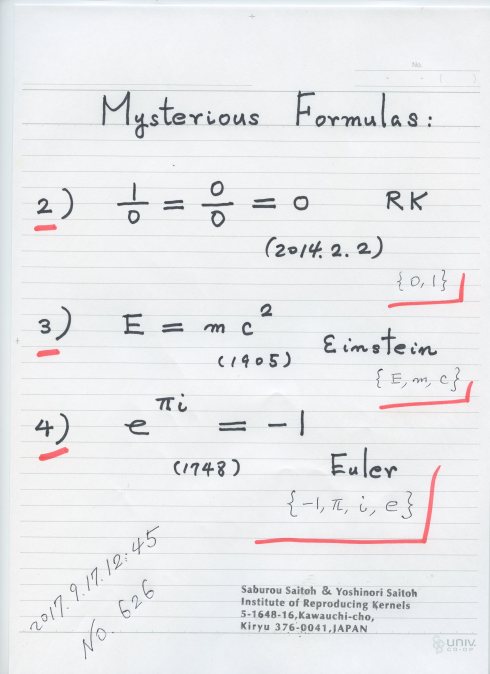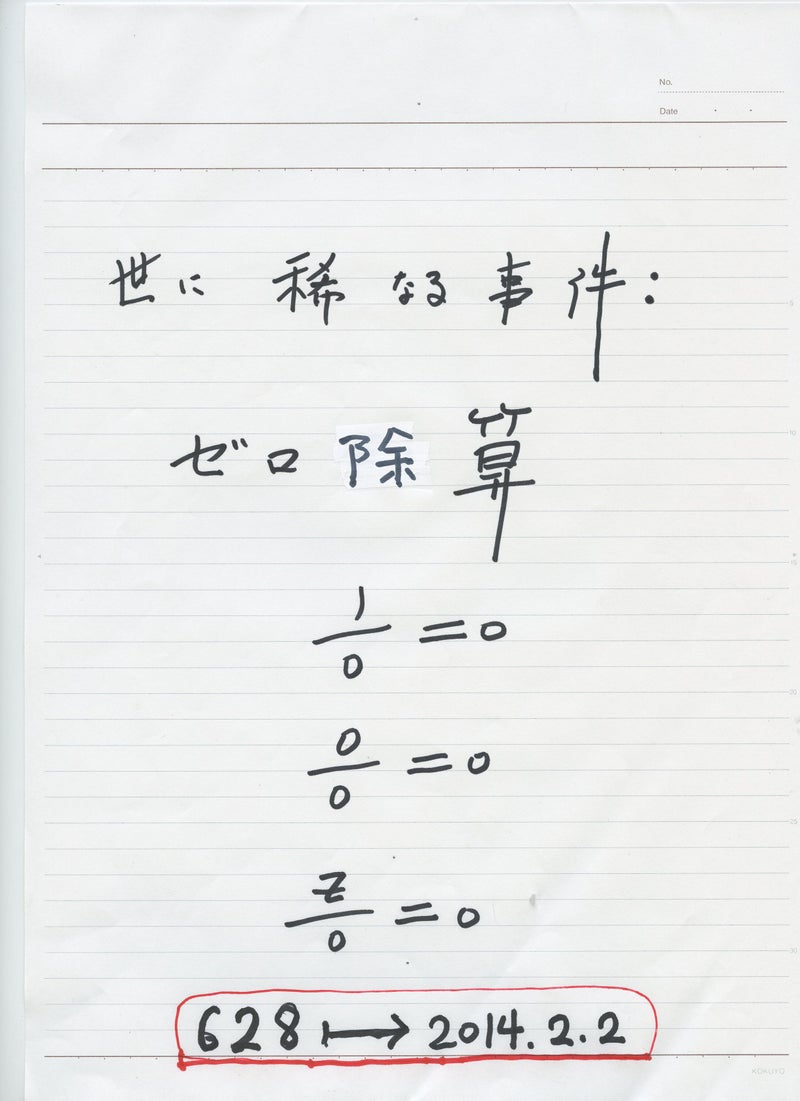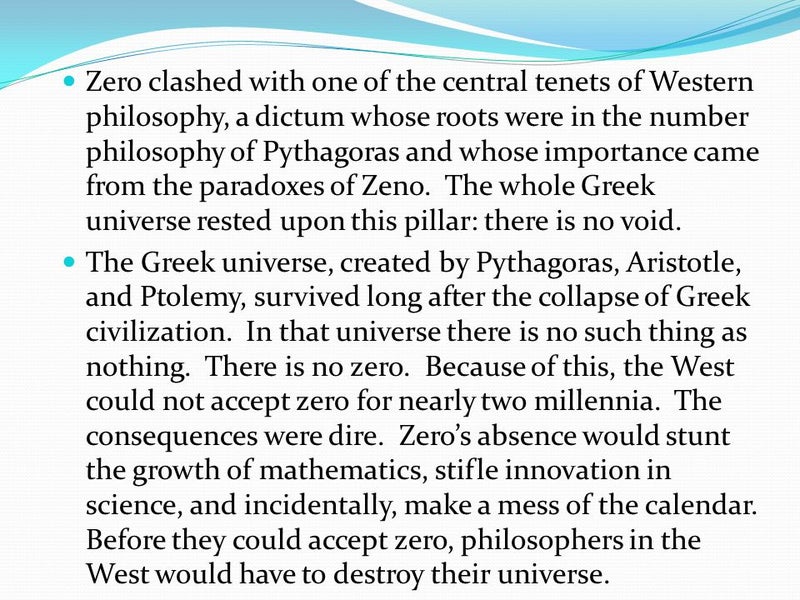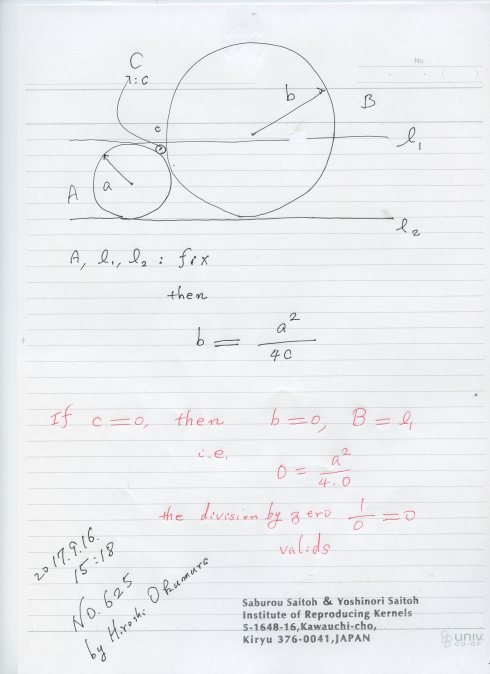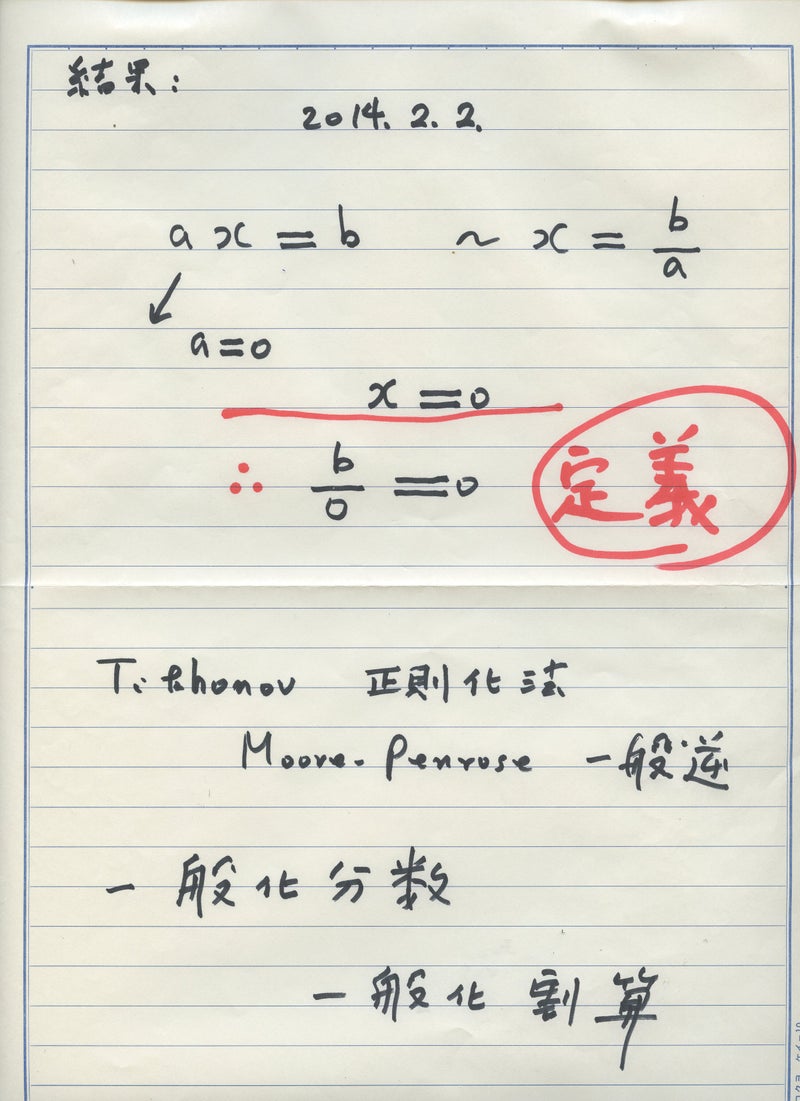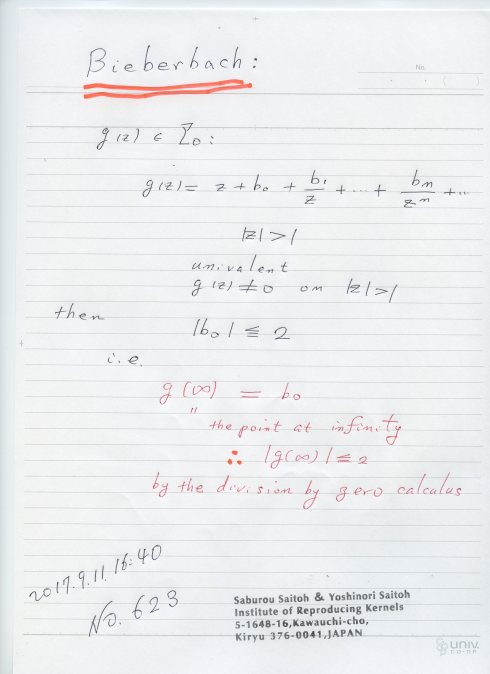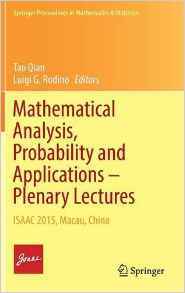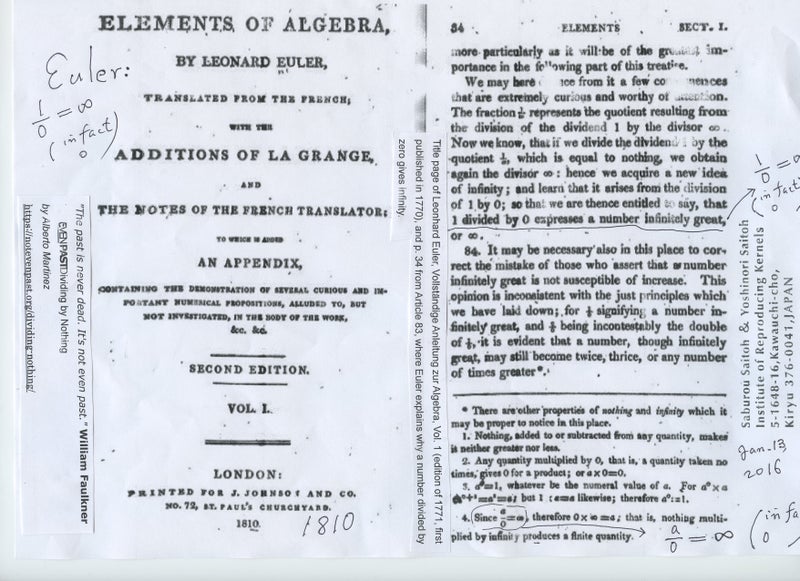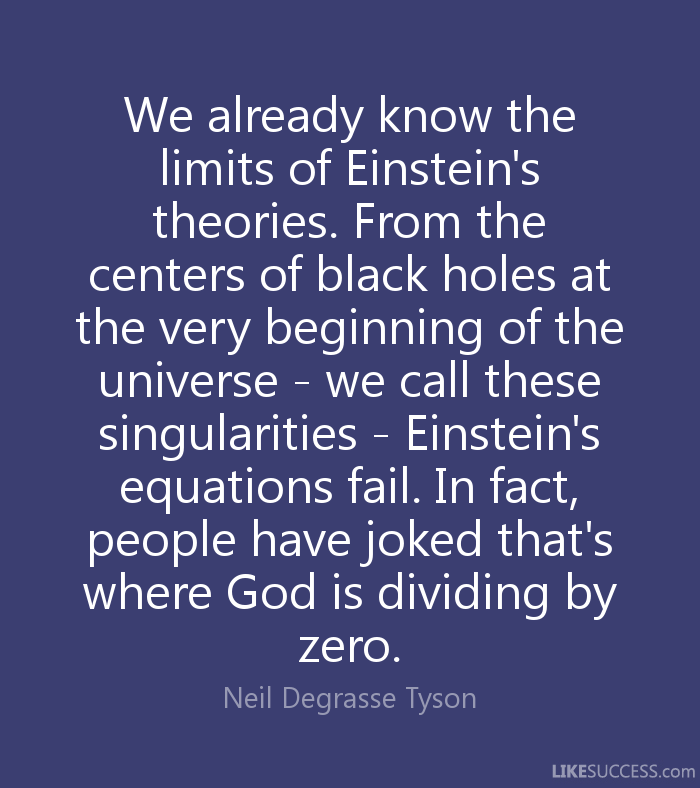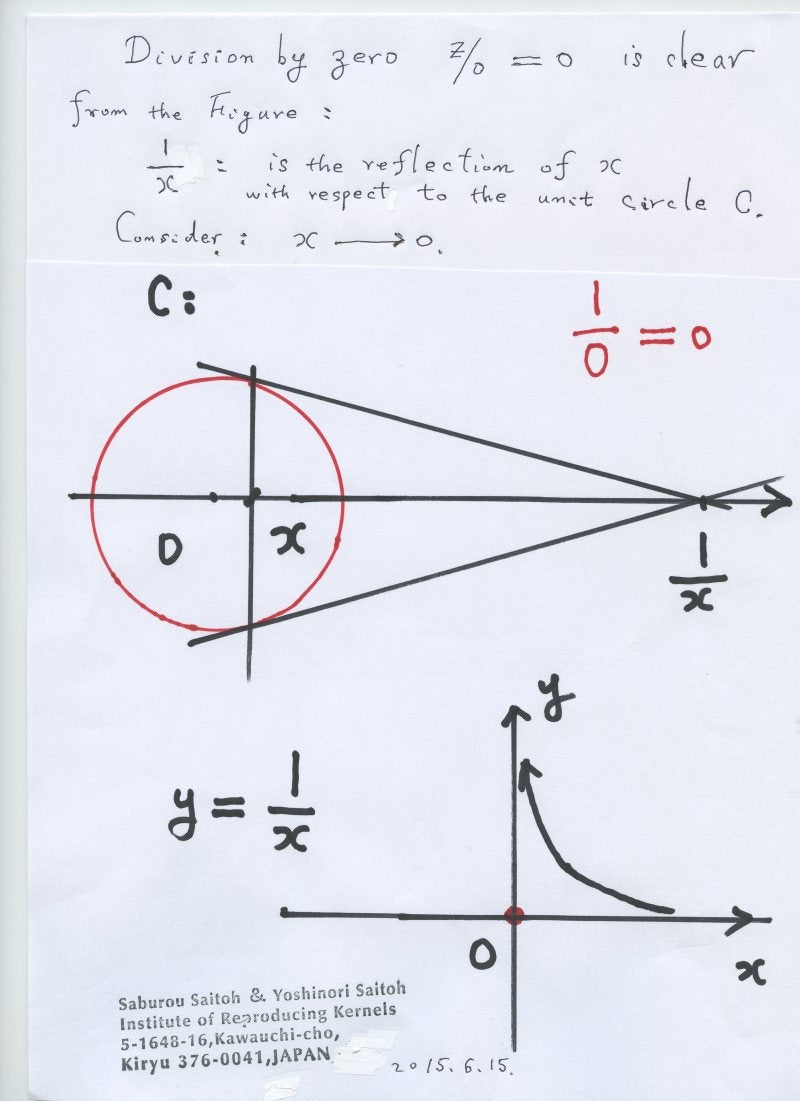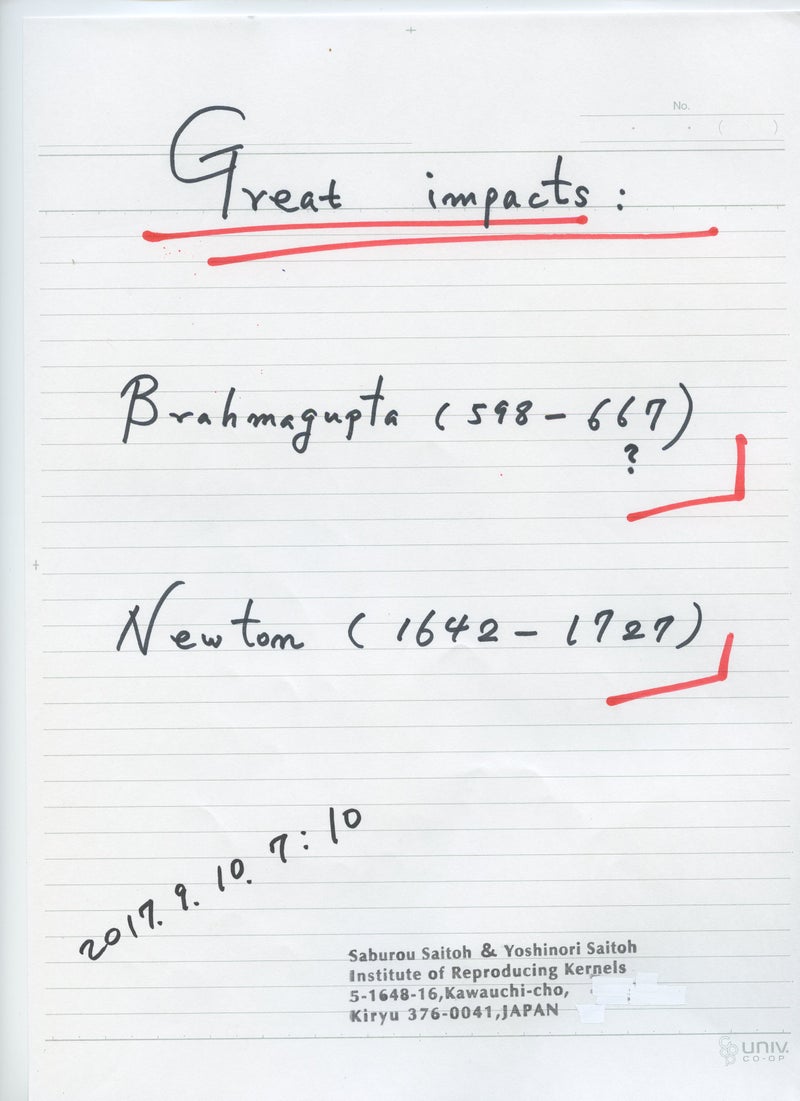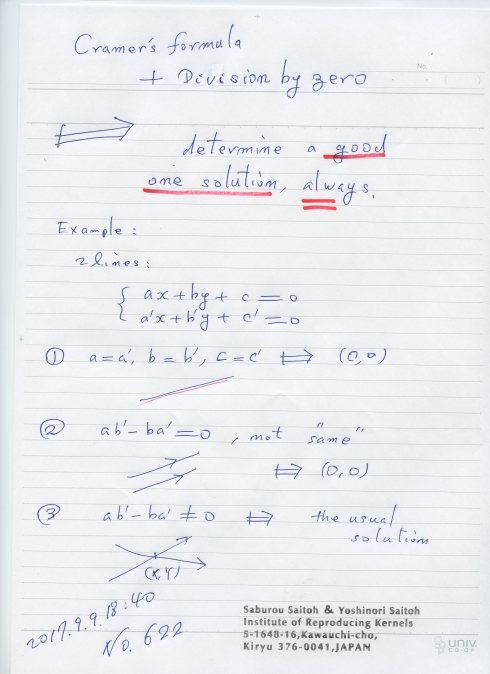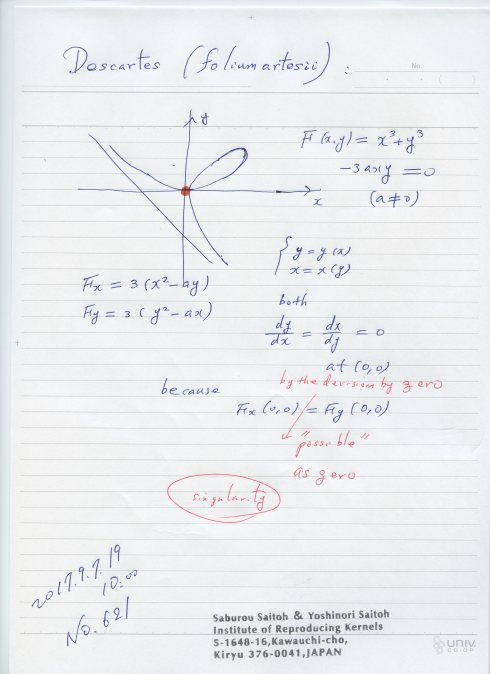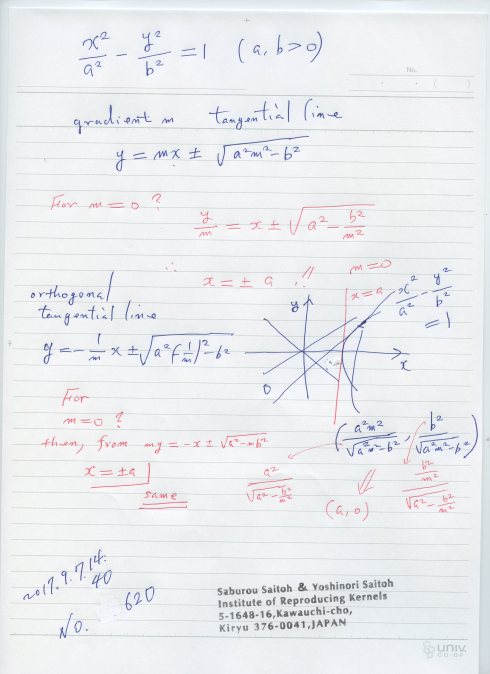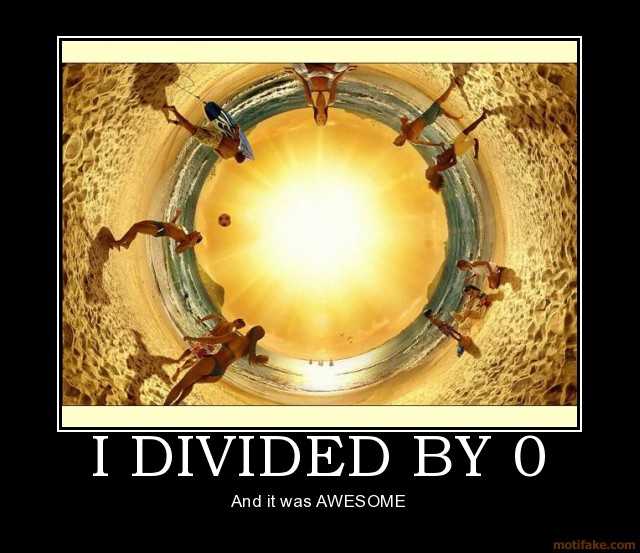№621
図の様に 特異点では、陽関数の微分係数が従来は定義されませんでしたが、 ゼロ除算算法で、新しい意味で、微分が定義されて、 特異点そのもので、数学を議論できます。
Dear the leading mathematicians and colleagues:
Apparently, the common sense on the division by zero with a long and mysterious history is wrong and our basic idea on the space around the point at infinity is also wrong since Euclid. On the gradient or on derivatives we have a great missing since $\tan (\pi/2) = 0$. Our mathematics is also wrong in elementary mathematics on the division by zero.
I wrote a simple draft on our division by zero. The contents are elementary and have wide connections to various fields beyond mathematics. I expect you write some philosophy, papers and essays on the division by zero from the attached source.
The division by zero is uniquely and reasonably determined as 1/0=0/0=z/0=0 in the natural extensions of fractions. We have to change our basic ideas for our space and world
Division by Zero z/0 = 0 in Euclidean Spaces
Hiroshi Michiwaki, Hiroshi Okumura and Saburou Saitoh
International Journal of Mathematics and Computation Vol. 28(2017); Issue 1, 2017), 1
-16.
http://www.scirp.org/journal/a lamt http://dx.doi.org/10.4236/alam t.2016.62007
http://www.ijapm.org/show-63-5 04-1.html
http://www.diogenes.bg/ijam/co ntents/2014-27-2/9/9.pdf
http://okmr.yamatoblog.net/div ision%20by%20zero/announcement %20326-%20the%20divi
http://okmr.yamatoblog.net/
Relations of 0 and infinity
Hiroshi Okumura, Saburou Saitoh and Tsutomu Matsuura:
http://www.e-jikei.org/…/Camer a%20ready%20manuscript_JTSS_A…
https://sites.google.com/site/ sandrapinelas/icddea-2017
我々の初等数学には 間違いと欠陥がある。
学部程度の数学は 相当に変更されるべきである。
しかしながら、ゼロ除算の真実を知れば、人間は 人間の愚かさ、人間が如何に予断と偏見、思い込みに囚われた存在 であるかを知ることが出来るだろう。この意味で、ゼロ除算は 人間開放に寄与するだろう。世界、社会が混乱を続けているのは、 人間の無智の故であると言える。
三角関数や2次曲線論でも理解は不完全で、無限の彼方の概念は、 ユークリッド以来 捉えられていないと言える。 (2017.8.23.06:30 昨夜 風呂でそのような想いが、新鮮な感覚で湧いて来た。)
ゼロ除算の優秀性、位置づけ: 要するに孤立特異点以外は すべて従来数学である。 ゼロ除算は、孤立特異点 そのもので、新しいことが言えるとなっている。従来、考えなかっ たこと、できなかったこと ができるようになったのであるから、ゼロ除算の優秀性は歴然であ る。 優秀性の大きさは、新しい発見の影響の大きさによる (2017.8.24.05:40)
思えば、我々は未だ微分係数、勾配、傾きの概念さえ、正しく理解 されていないと言える。 目覚めた時そのような考えが独りでに湧いた。)
\documentclass[12pt]{article}
\usepackage{latexsym,amsmath,amssymb,amsfonts,amstext,amsthm}
\numberwithin{equation}{section}
\begin{document}
\title{\bf Announcement 352: On the third birthday of the division by zero z/0=0 \\
(2017.2.2)}
\author{{\it Institute of Reproducing Kernels}\\
Kawauchi-cho, 5-1648-16,\\
Kiryu 376-0041, Japan\\
}
\date{\today}
\maketitle
{\bf Abstract: } In this announcement, for its importance we would like to state the
situation on the division by zero and propose basic new challenges to education and research on our wrong world history of the division by zero.
\bigskip
\section{Introduction}
%\label{sect1}
By a {\bf natural extension} of the fractions
\begin{equation}
\frac{b}{a}
\end{equation}
for any complex numbers $a$ and $b$, we found the simple and beautiful result, for any complex number $b$
\begin{equation}
\frac{b}{0}=0,
\end{equation}
incidentally in \cite{s} by the Tikhonov regularization for the Hadamard product inversions for matrices and we discussed their properties and gave several physical interpretations on the general fractions in \cite{kmsy} for the case of real numbers.
The division by zero has a long and mysterious story over the world (see, for example, H. G. Romig \cite{romig} and Google site with the division by zero) with its physical viewpoints since the document of zero in India on AD 628. In particular, note that Brahmagupta (598 –
668 ?) established the four arithmetic operations by introducing $0$ and at the same time he defined as $0/0=0$ in Brāhmasphuṭasiddhānta. Our world history, however, stated that his definition $0/0=0$ is wrong over 1300 years, but, we will see that his definition is suitable. However, we do not know the meaning and motivation of the definition of $0/0=0$, furthermore, for the important case $1/0$ we do not know any result there. However,
Sin-Ei Takahasi (\cite{kmsy}) established a simple and decisive interpretation (1.2) by analyzing the extensions of fractions and by showing the complete characterization for the property (1.2):
\bigskip
{\bf Proposition 1. }{\it Let F be a function from ${\bf C }\times {\bf C }$ to ${\bf C }$ satisfying
$$
F (b, a)F (c, d)= F (bc, ad)
$$
for all
$$
a, b, c, d \in {\bf C }
$$
and
$$
F (b, a) = \frac {b}{a }, \quad a, b \in {\bf C }, a \ne 0.
$$
Then, we obtain, for any $b \in {\bf C } $
$$
F (b, 0) = 0.
$$
}
Note that the complete proof of this proposition is simply given by 2 or 3 lines.
We {\bf should define $F(b,0)= b/0 =0$}, in general.
\medskip
We thus should consider, for any complex number $b$, as (1.2);
that is, for the mapping
\begin{equation}
W = \frac{1}{z},
\end{equation}
the image of $z=0$ is $W=0$ ({\bf should be defined}). This fact seems to be a curious one in connection with our well-established popular image for the point at infinity on the Riemann sphere. Therefore, the division by zero will give great impacts to complex analysis and to our ideas for the space and universe.
For Proposition 1, we see some confusion even among mathematicians; for the elementary function (1.3), we did not consider the value at $z=0$, and we were not able to consider a value. Many and many people consider its value by the limiting like $+\infty$, $-\infty$ or the point at infinity as $\infty$. However, their basic idea comes from {\bf continuity} with the common sense or based on the basic idea of Aristotle. However, by the division by zero (1.2) we will consider its value of the function $W = \frac{1}{z}$ as zero at $z=0$. We would like to consider the value so. We will see that this new definition is valid widely in mathematics and mathematical sciences. However, for functions, we will need some modification {\bf by the idea of the division by zero calculus } as in stated in the sequel.
Meanwhile, the division by zero (1.2) is clear, indeed, for the introduction of (1.2), we have several independent approaches as in:
\medskip
1) by the generalization of the fractions by the Tikhonov regularization and by the Moore-Penrose generalized inverse,
\medskip
2) by the intuitive meaning of the fractions (division) by H. Michiwaki – repeated subtraction method,
\medskip
3) by the unique extension of the fractions by S. Takahasi, as in the above,
\medskip
4) by the extension of the fundamental function $W = 1/z$ from ${\bf C} \setminus \{0\}$ into ${\bf C}$ such that $W =1/z$ is a one to one and onto mapping from $ {\bf C} \setminus \{0\} $ onto ${\bf C} \setminus \{0\}$ and the division by zero $1/0=0$ is a one to one and onto mapping extension of the function $W =1/z $ from ${\bf C}$ onto ${\bf C}$,
\medskip
and
\medskip
5) by considering the values of functions with the mean values of functions.
\medskip
Furthermore, in (\cite{msy}) we gave the results in order to show the reality of the division by zero in our world:
\medskip
\medskip
A) a field structure containing the division by zero — the Yamada field ${\bf Y}$,
\medskip
B) by the gradient of the $y$ axis on the $(x,y)$ plane — $\tan \frac{\pi}{2} =0$,
\medskip
C) by the reflection $W =1/\overline{z}$ of $W= z$ with respect to the unit circle with center at the origin on the complex $z$ plane — the reflection point of zero is zero, not the point at infinity.
\medskip
and
\medskip
D) by considering rotation of a right circular cone having some very interesting
phenomenon from some practical and physical problem.
\medskip
In (\cite{mos}), many division by zero results in Euclidean spaces are given and the basic idea at the point at infinity should be changed. In (\cite{ms}), we gave beautiful geometrical interpretations of determinants from the viewpoint of the division by zero. The results show that the division by zero is our basic and elementary mathematics in our world.
\medskip
See J. A. Bergstra, Y. Hirshfeld and J. V. Tucker \cite{bht} and J. A. Bergstra \cite{berg} for the relationship between fields and the division by zero, and the importance of the division by zero for computer science. It seems that the relationship of the division by zero and field structures are abstract in their papers.
Meanwhile, J. P. Barukcic and I. Barukcic (\cite{bb}) discussed the relation between the divisions $0/0$, $1/0$ and special relative theory of Einstein. However, their logic seems to be curious and their results contradict with ours.
Furthermore, T. S. Reis and J.A.D.W. Anderson (\cite{ra,ra2}) extend the system of the real numbers by introducing an ideal number for the division by zero.
Meanwhile, we should refer to up-to-date information:
{\it Riemann Hypothesis Addendum – Breakthrough
Kurt Arbenz
https://www.researchgate.net/publication/272022137 Riemann Hypothesis Addendum – Breakthrough.}
\medskip
Here, we recall Albert Einstein’s words on mathematics:
Blackholes are where God divided by zero.
I don’t believe in mathematics.
George Gamow (1904-1968) Russian-born American nuclear physicist and cosmologist remarked that “it is well known to students of high school algebra” that division by zero is not valid; and Einstein admitted it as {\bf the biggest blunder of his life}:
Gamow, G., My World Line (Viking, New York). p 44, 1970.
Apparently, the division by zero is a great missing in our mathematics and the result (1.2) is definitely determined as our basic mathematics, as we see from Proposition 1. Note its very general assumptions and many fundamental evidences in our world in (\cite{kmsy,msy,mos,s16}). The results will give great impacts on Euclidean spaces, analytic geometry, calculus, differential equations, complex analysis and physical problems.
The mysterious history of the division by zero over one thousand years is a great shame of mathematicians and human race on the world history, like the Ptolemaic system (geocentric theory). The division by zero will become a typical symbol of foolish human race with long and unceasing struggles. Future people will realize this fact as a definite common sense.
We should check and fill our mathematics, globally and beautifully, from the viewpoint of the division by zero. Our mathematics will be more perfect and beautiful, and will give great impacts to our basic ideas on the universe.
For our ideas on the division by zero, see the survey style announcements.
\section{Basic Materials of Mathematics}
\medskip
(1): First, we should declare that the divison by zero is {\bf possible in the natural and uniquley determined sense and its importance}.
(2): In the elementary school, we should introduce the concept of division (fractions) by the idea of repeated subtraction method by H. Michiwaki whoes method is applied in computer algorithm and in old days for calculation of division. This method will give a simple and clear method for calculation of division and students will be happy to apply this simple method at the first stage. At this time, they will be able to understand that the division by zero is clear and trivial as $a/0=0$ for any $a$. Note that Michiwaki knows how to apply his method to the complex number field.
(3): For the introduction of the elemetary function $y= 1/x$, we should give the definition of the function at the origin $x=0$ as $y = 0$ by the division by zero idea and we should apply this definition for the occasions of its appearences, step by step, following the curriculum and the results of the division by zero.
(4): For the idea of the Euclidean space (plane), we should introduce, at the first stage, the concept of stereographic projection and the concept of the point at infinity –
one point compactification. Then, we will be able to see the whole Euclidean plane, however, by the division by zero, {\bf the point at infinity is represented by zero, not by $\infty$}. We can teach the very important fact with many geometric and analytic geometry methods. These topics will give great pleasant feelings to many students.
Interesting topics are: parallel lines, what is a line? – a line contains the origin as an isolated
point for the case that the native line does not through the origin. All the lines pass the origin, our space is not the Eulcildean space and is not Aristoteles for the strong discontinuity at the point at infinity (at the origin). – Here note that an orthogonal coordinate system should be fixed first for our all arguments.
(5): The inversion of the origin with respect to a circle with center the origin is the origin itself, not the point at infinity – the very classical result is wrong. We can also prove this elementary result by many elementary ways.
(6): We should change the concept of gradients; on the usual orthogonal coordinates $(x,y)$,
the gradient of the $y$ axis is zero; this is given and proved by the fundamental result
$\tan (\pi/2) =0$. The result is also trivial from the definition of the Yamada field.
\medskip
For the Fourier coefficients $a_k$ of a function :
$$
\frac{a_k \pi k^3}{4}
$$
\begin{equation}
= \sin (\pi k) \cos (\pi k) + 2 k^2 \pi^2 \sin(\pi k) \cos (\pi k) + 2\pi (\cos (\pi k) )^2 – \pi k,
\end{equation}
for $k=0$, we obtain immediately
\begin{equation}
a_0 = \frac{8}{3}\pi^2
\end{equation}
(see \cite{maple}, (3.4))({ –
Difficulty in Maple for specialization problems}
).
\medskip
These results are derived also from the {\bf division by zero calculus}:
For any formal Laurent expansion around $z=a$,
\begin{equation}
f(z) = \sum_{n=-\infty}^{\infty} C_n (z – a)^n,
\end{equation}
we obtain the identity, by the division by zero
\begin{equation}
f(a) = C_0.
\end{equation}
\medskip
The typical example is that, as we can derive by the elementary way,
$$
\tan \frac{\pi}{2} =0.
$$
\medskip
We gave many examples with geometric meanings in \cite{mos}.
This fundamental result leads to the important new definition:
From the viewpoint of the division by zero, when there exists the limit, at $ x$
\begin{equation}
f^\prime(x) = \lim_{h\to 0} \frac{f(x + h) – f(x)}{h} =\infty
\end{equation}
or
\begin{equation}
f^\prime(x) = -\infty,
\end{equation}
both cases, we can write them as follows:
\begin{equation}
f^\prime(x) = 0.
\end{equation}
\medskip
For the elementary ordinary differential equation
\begin{equation}
y^\prime = \frac{dy}{dx} =\frac{1}{x}, \quad x > 0,
\end{equation}
how will be the case at the point $x = 0$? From its general solution, with a general constant $C$
\begin{equation}
y = \log x + C,
\end{equation}
we see that, by the division by zero,
\begin{equation}
y^\prime (0)= \left[ \frac{1}{x}\right]_{x=0} = 0,
\end{equation}
that will mean that the division by zero (1.2) is very natural.
In addition, note that the function $y = \log x$ has infinite order derivatives and all the values are zero at the origin, in the sense of the division by zero.
However, for the derivative of the function $y = \log x$, we have to fix the sense at the origin, clearly, because the function is not differentiable, but it has a singularity at the origin. For $x >0$, there is no problem for (2.8) and (2.9). At $x = 0$, we see that we can not consider the limit in the sense (2.5). However, for $x >0$ we have (2.8) and
\begin{equation}
\lim_{x \to +0} \left(\log x \right)^\prime = +\infty.
\end{equation}
In the usual sense, the limit is $+\infty$, but in the present case, in the sense of the division by zero, we have:
\begin{equation}
\left[ \left(\log x \right)^\prime \right]_{x=0}= 0
\end{equation}
and we will be able to understand its sense graphycally.
By the new interpretation for the derivative, we can arrange many formulas for derivatives, by the division by zero. We can modify many formulas and statements in calculus and we can apply our concept to the differential equation theory and the universe in connetion with derivatives.
(7): We shall introduce the typical division by zero calculus.
For the integral
\begin{equation}
\int x(x^{2}+1)^{a}dx=\frac{(x^{2}+1)^{a+1}}{2(a+1)}\quad(a\ne-1),
\end{equation}
we obtain, by the division by zero calculus,
\begin{equation}
\int x(x^{2}+1)^{-1}dx=\frac{\log(x^{2}+1)}{2}.
\end{equation}
For example, in the ordinary differential equation
\begin{equation}
y^{\prime\prime} + 4 y^{\prime} + 3 y = 5 e^{- 3x},
\end{equation}
in order to look for a special solution, by setting $y = A e^{kx}$ we have, from
\begin{equation}
y^{\prime\prime} + 4 y^{\prime} + 3 y = 5 e^{kx},
\end{equation}
\begin{equation}
y = \frac{5 e^{kx}}{k^2 + 4 k + 3}.
\end{equation}
For $k = -3$, by the division by zero calculus, we obtain
\begin{equation}
y = e^{-3x} \left( – \frac{5}{2}x – \frac{5}{4}\right),
\end{equation}
and so, we can obtain the special solution
\begin{equation}
y = – \frac{5}{2}x e^{-3x}.
\end{equation}
In those examples, we were able to give valuable functions for denominator zero cases. The division by zero calculus may be applied to many cases as a new fundamental calculus over l’Hopital’s rule.
(8): When we apply the division by zero to functions, we can consider, in general, many ways. For example,
for the function $z/(z-1)$, when we insert $z=1$ in numerator and denominator, we have
\begin{equation}
\left[\frac{z}{z-1}\right]_{z = 1} = \frac{1}{0} =0.
\end{equation}
However,
from the identity —
the Laurent expansion around $z=1$,
\begin{equation}
\frac{z}{z-1} = \frac{1}{z-1} + 1,
\end{equation}
we have
\begin{equation}
\left[\frac{z}{z-1}\right]_{z = 1} = 1.
\end{equation}
For analytic functions we can give uniquely determined values at isolated singular points by the values by means of the Laurent expansions as the division by zero calculus, however, the values by means of the Laurent expansions are not always reasonable. We will need to consider many interpretations for reasonable values. In many formulas in mathematics and physics, however, we can see that the division by zero calculus is reasonably valid. See \cite{kmsy,msy}.
\section{Albert Einstein’s biggest blunder}
The division by zero is directly related to the Einstein’s theory and various
physical problems
containing the division by zero. Now we should check the theory and the problems by the concept of the RIGHT and DEFINITE division by zero. Now is the best time since 100 years from Albert Einstein. It seems that the background knowledge is timely fruitful.
Note that the Big Bang also may be related to the division by zero like the blackholes.
\section{Computer systems}
The above Professors listed are wishing the contributions in order to avoid the division by zero trouble in computers. Now, we should arrange new computer systems in order not to meet the division by zero trouble in computer systems.
By the division by zero calculus, we will be able to overcome troubles in Maple for specialization problems as in stated.
\section{General ideas on the universe}
The division by zero may be related to religion, philosophy and the ideas on the universe; it will create a new world. Look at the new world introduced.
\bigskip
We are standing on a new generation and in front of the new world, as in the discovery of the Americas. Should we push the research and education on the division by zero?
\bigskip
\section{\bf Fundamental open problem}
{\bf Fundamental open problem}: {\it Give the definition of the division by zero calculus for several -variables functions with singularities.}
\medskip
In order to make clear the problem, we give a prototype example.
We have the identity by the divison by zero calculus: For
\begin{equation}
f(z) = \frac{1 + z}{1- z}, \quad f(1) = -1.
\end{equation}
From the real part and imaginary part of the function, we have, for $ z= x +iy$
\begin{equation}
\frac{1 – x^2 – y^2}{(1 – x)^2 + y^2} =-1, \quad \text{at}\quad (1,0)
\end{equation}
and
\begin{equation}
\frac{y}{(1- x)^2 + y^2} = 0, \quad \text{at}\quad (1,0),
\end{equation}
respectively. Why the differences do happen? In general, we are interested in the above open problem. Recall our definition for the division by zero calculus.
\bibliographystyle{plain}
\begin{thebibliography}{10}
\bibitem{bb}
J. P. Barukcic and I. Barukcic, Anti Aristotle –
The Division of Zero by Zero. Journal of Applied Mathematics and Physics, {\bf 4}(2016), 749-761.
doi: 10.4236/jamp.2016.44085.
\bibitem{bht}
J. A. Bergstra, Y. Hirshfeld and J. V. Tucker,
Meadows and the equational specification of division (arXiv:0901.0823v1[math.RA] 7 Jan 2009).
\bibitem{berg}
J.A. Bergstra, Conditional Values in Signed Meadow Based Axiomatic Probability Calculus,
arXiv:1609.02812v2[math.LO] 17 Sep 2016.
\bibitem{cs}
L. P. Castro and S. Saitoh, Fractional functions and their representations, Complex Anal. Oper. Theory {\bf7} (2013), no. 4, 1049-1063.
\bibitem{kmsy}
M. Kuroda, H. Michiwaki, S. Saitoh, and M. Yamane,
New meanings of the division by zero and interpretations on $100/0=0$ and on $0/0=0$,
Int. J. Appl. Math. {\bf 27} (2014), no 2, pp. 191-198, DOI: 10.12732/ijam.v27i2.9.
\bibitem{msy}
H. Michiwaki, S. Saitoh, and M.Yamada,
Reality of the division by zero $z/0=0$. IJAPM International J. of Applied Physics and Math. {\bf 6}(2015), 1–8. http://www.ijapm.org/show-63-504-1.html
\bibitem{ms}
T. Matsuura and S. Saitoh,
Matrices and division by zero $z/0=0$, Advances in Linear Algebra
\& Matrix Theory, 6 (2016), 51-58. http://dx.doi.org/10.4236/alamt.2016.62007 http://www.scirp.org/journal/alamt
\bibitem{mos}
H. Michiwaki, H. Okumura, and S. Saitoh,
Division by Zero $z/0 = 0$ in Euclidean Spaces.
International Journal of Mathematics and Computation Vol. 28(2017); Issue 1, 2017), 1-16.
\bibitem{ra}
T. S. Reis and J.A.D.W. Anderson,
Transdifferential and Transintegral Calculus,
Proceedings of the World Congress on Engineering and Computer Science 2014 Vol I
WCECS 2014, 22-24 October, 2014, San Francisco, USA
\bibitem{ra2}
T. S. Reis and J.A.D.W. Anderson,
Transreal Calculus,
IAENG International J. of Applied Math., {\bf 45}(2015): IJAM 45 1 06.
\bibitem{romig}
H. G. Romig, Discussions: Early History of Division by Zero,
American Mathematical Monthly, Vol. 31, No. 8. (Oct., 1924), pp. 387-389.
\bibitem{s}
S. Saitoh, Generalized inversions of Hadamard and tensor products for matrices, Advances in Linear Algebra \& Matrix Theory. {\bf 4} (2014), no. 2, 87–95. http://www.scirp.org/journal/ALAMT/
\bibitem{s16}
S. Saitoh, A reproducing kernel theory with some general applications,
Qian,T./Rodino,L.(eds.): Mathematical Analysis, Probability and Applications – Plenary Lectures: Isaac 2015, Macau, China, Springer Proceedings in Mathematics and Statistics, {\bf 177}(2016), 151-182 (Springer).
\bibitem{ttk}
S.-E. Takahasi, M. Tsukada and Y. Kobayashi, Classification of continuous fractional binary operations on the real and complex fields, Tokyo Journal of Mathematics, {\bf 38}(2015), no. 2, 369-380.
\bibitem{maple}
Introduction to Maple – UBC Mathematics
クリックしてlesson1.pdfにアクセス
\bibitem{ann179}
Announcement 179 (2014.8.30): Division by zero is clear as z/0=0 and it is fundamental in mathematics.
\bibitem{ann185}
Announcement 185 (2014.10.22): The importance of the division by zero $z/0=0$.
\bibitem{ann237}
Announcement 237 (2015.6.18): A reality of the division by zero $z/0=0$ by geometrical optics.
\bibitem{ann246}
Announcement 246 (2015.9.17): An interpretation of the division by zero $1/0=0$ by the gradients of lines.
\bibitem{ann247}
Announcement 247 (2015.9.22): The gradient of y-axis is zero and $\tan (\pi/2) =0$ by the division by zero $1/0=0$.
\bibitem{ann250}
Announcement 250 (2015.10.20): What are numbers? – the Yamada field containing the division by zero $z/0=0$.
\bibitem{ann252}
Announcement 252 (2015.11.1): Circles and
curvature – an interpretation by Mr.
Hiroshi Michiwaki of the division by
zero $r/0 = 0$.
\bibitem{ann281}
Announcement 281 (2016.2.1): The importance of the division by zero $z/0=0$.
\bibitem{ann282}
Announcement 282 (2016.2.2): The Division by Zero $z/0=0$ on the Second Birthday.
\bibitem{ann293}
Announcement 293 (2016.3.27): Parallel lines on the Euclidean plane from the viewpoint of division by zero 1/0=0.
\bibitem{ann300}
Announcement 300 (2016.05.22): New challenges on the division by zero z/0=0.
\bibitem{ann326}
Announcement 326 (2016.10.17): The division by zero z/0=0 – its impact to human beings through education and research.
\end{thebibliography}
\end{document}
\documentclass[12pt]{article}
\usepackage{latexsym,amsmath,amssymb,amsfonts,amstext,amsthm}
\numberwithin{equation}{section}
\begin{document}
\title{\bf Announcement 362: Discovery of the division by zero as \\
$0/0=1/0=z/0=0$\\
(2017.5.5)}
\author{{\it Institute of Reproducing Kernels}\\
Kawauchi-cho, 5-1648-16,\\
Kiryu 376-0041, Japan\\
}
\date{\today}
\maketitle
{\bf Statement: } The Institute of Reproducing Kernels declares that the division by zero was discovered as $0/0=1/0=z/0=0$ in a natural sense on 2014.2.2. The result shows a new basic idea on the universe and space since Aristotelēs (BC384 – BC322) and Euclid (BC 3 Century – ), and the division by zero is since Brahmagupta (598 – 668 ?).
In particular, Brahmagupta defined as $0/0=0$ in Brāhmasphuṭasiddhānta (628), however, our world history stated that his definition $0/0=0$ is wrong over 1300 years, but, we will see that his definition is suitable.
For the details, see the references and the site: http://okmr.yamatoblog.net/
\bibliographystyle{plain}
\begin{thebibliography}{10}
\bibitem{kmsy}
M. Kuroda, H. Michiwaki, S. Saitoh, and M. Yamane,
New meanings of the division by zero and interpretations on $100/0=0$ and on $0/0=0$,
Int. J. Appl. Math. {\bf 27} (2014), no 2, pp. 191-198, DOI: 10.12732/ijam.v27i2.9.
\bibitem{msy}
H. Michiwaki, S. Saitoh, and M.Yamada,
Reality of the division by zero $z/0=0$. IJAPM International J. of Applied Physics and Math. {\bf 6}(2015), 1–8. http://www.ijapm.org/show-63-504-1.html
\bibitem{ms}
T. Matsuura and S. Saitoh,
Matrices and division by zero $z/0=0$, Advances in Linear Algebra
\& Matrix Theory, 6 (2016), 51-58. http://dx.doi.org/10.4236/alamt.2016.62007 http://www.scirp.org/journal/alamt
\bibitem{mos}
H. Michiwaki, H. Okumura, and S. Saitoh,
Division by Zero $z/0 = 0$ in Euclidean Spaces.
International Journal of Mathematics and Computation Vol. 28(2017); Issue 1, 2017), 1-16.
\bibitem{osm}
H. Okumura, S. Saitoh and T. Matsuura, Relations of $0$ and $\infty$,
Journal of Technology and Social Science (JTSS), 1(2017), 70-77.
\bibitem{romig}
H. G. Romig, Discussions: Early History of Division by Zero,
American Mathematical Monthly, Vol. 31, No. 8. (Oct., 1924), pp. 387-389.
\bibitem{s}
S. Saitoh, Generalized inversions of Hadamard and tensor products for matrices, Advances in Linear Algebra \& Matrix Theory. {\bf 4} (2014), no. 2, 87–95. http://www.scirp.org/journal/ALAMT/
\bibitem{s16}
S. Saitoh, A reproducing kernel theory with some general applications,
Qian,T./Rodino,L.(eds.): Mathematical Analysis, Probability and Applications – Plenary Lectures: Isaac 2015, Macau, China, Springer Proceedings in Mathematics and Statistics, {\bf 177}(2016), 151-182 (Springer).
\bibitem{ttk}
S.-E. Takahasi, M. Tsukada and Y. Kobayashi, Classification of continuous fractional binary operations on the real and complex fields, Tokyo Journal of Mathematics, {\bf 38}(2015), no. 2, 369-380.
\bibitem{ann179}
Announcement 179 (2014.8.30): Division by zero is clear as z/0=0 and it is fundamental in mathematics.
\bibitem{ann185}
Announcement 185 (2014.10.22): The importance of the division by zero $z/0=0$.
\bibitem{ann237}
Announcement 237 (2015.6.18): A reality of the division by zero $z/0=0$ by geometrical optics.
\bibitem{ann246}
Announcement 246 (2015.9.17): An interpretation of the division by zero $1/0=0$ by the gradients of lines.
\bibitem{ann247}
Announcement 247 (2015.9.22): The gradient of y-axis is zero and $\tan (\pi/2) =0$ by the division by zero $1/0=0$.
\bibitem{ann250}
Announcement 250 (2015.10.20): What are numbers? – the Yamada field containing the division by zero $z/0=0$.
\bibitem{ann252}
Announcement 252 (2015.11.1): Circles and
curvature – an interpretation by Mr.
Hiroshi Michiwaki of the division by
zero $r/0 = 0$.
\bibitem{ann281}
Announcement 281 (2016.2.1): The importance of the division by zero $z/0=0$.
\bibitem{ann282}
Announcement 282 (2016.2.2): The Division by Zero $z/0=0$ on the Second Birthday.
\bibitem{ann293}
Announcement 293 (2016.3.27): Parallel lines on the Euclidean plane from the viewpoint of division by zero 1/0=0.
\bibitem{ann300}
Announcement 300 (2016.05.22): New challenges on the division by zero z/0=0.
\bibitem{ann326}
Announcement 326 (2016.10.17): The division by zero z/0=0 – its impact to human beings through education and research.
\bibitem{ann352}
Announcement 352(2017.2.2): On the third birthday of the division by zero z/0=0.
\bibitem{ann354}
Announcement 354(2017.2.8): What are $n = 2,1,0$ regular polygons inscribed in a disc? — relations of $0$ and infinity.
\end{thebibliography}
\end{document}
再生核研究所声明371(2017.6.27)ゼロ除算の講演― 国際会議 https://sites.google.com/site/sandrapinelas/icddea-2017 報告
http://ameblo.jp/syoshinoris/theme-10006253398.html
1/0=0、0/0=0、z/0=0
http://ameblo.jp/syoshinoris/entry-12276045402.html
1/0=0、0/0=0、z/0=0
http://ameblo.jp/syoshinoris/entry-12263708422.html
1/0=0、0/0=0、z/0=0
http://ameblo.jp/syoshinoris/entry-12272721615.html




